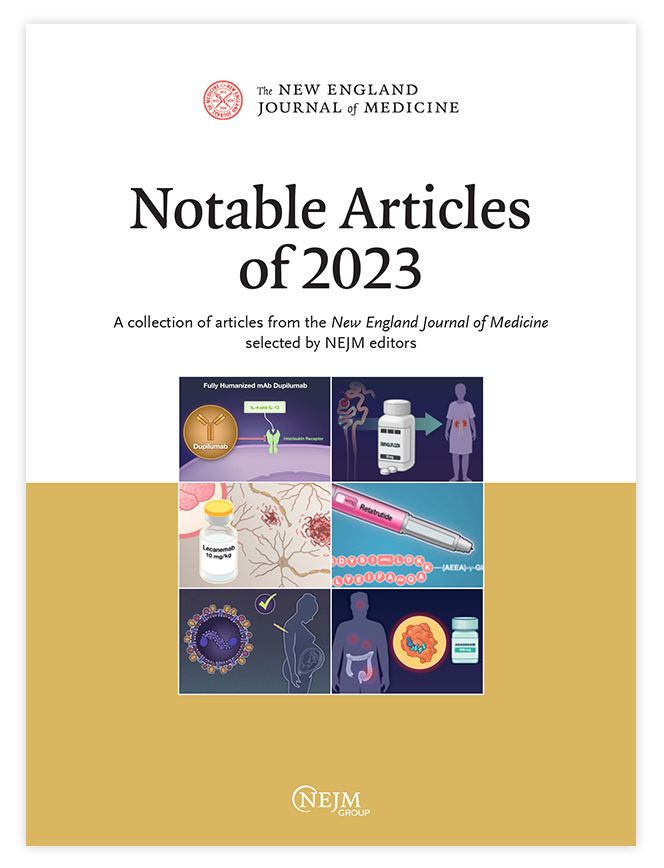强的松或甲氨蝶呤治疗肺结节病的一线治疗。
IF 96.2
1区 医学
Q1 MEDICINE, GENERAL & INTERNAL
引用次数: 0
摘要
背景:泼尼松目前被推荐作为肺结节病的一线治疗药物,但有许多副作用。甲氨蝶呤被推荐作为二线治疗,其副作用似乎比强的松少,但起效较慢。甲氨蝶呤与强的松作为肺结节病一线治疗的疗效和副作用资料有待研究。方法:在这项多中心、开放标签、非劣效性试验中,研究人员根据预先指定的治疗计划,以1:1的比例随机分配患者接受强的松或甲氨蝶呤治疗。主要终点是从基线到第24周预测的强制肺活量(FVC)百分比的平均变化,使用混合模型进行重复测量。主要终点的非劣效性裕度为5个百分点。结果138例随机分组患者中,70例接受强的松治疗,68例接受甲氨蝶呤治疗。从基线到第24周,预估FVC百分比的未调整平均变化在强的松组为6.75个百分点(95%可信区间[CI], 4.50至8.99),在甲氨蝶呤组为6.11个百分点(95% CI, 3.72至8.50)。在主要终点方面,甲氨蝶呤不逊于强的松,调整后的组间差异为-1.17个百分点(95% CI, -4.27至1.93)。在两个试验组中,不良事件发生的患者比例相似。体重增加、失眠和食欲增加是强的松最常见的不良反应,而恶心、疲劳和任何肝功能检查异常是甲氨蝶呤最常见的不良反应。结论在肺结节病患者中,从基线到第24周预测FVC百分比的变化,甲氨蝶呤初始治疗不低于强的松治疗。甲氨蝶呤和强的松在副作用方面的差异可能会使提供者和患者共同决定适当的治疗方法。(由荷兰肺基金会资助;PREDMETH ClinicalTrials.gov号码:NCT04314193)。本文章由计算机程序翻译,如有差异,请以英文原文为准。
First-Line Treatment of Pulmonary Sarcoidosis with Prednisone or Methotrexate.
BACKGROUND
Prednisone is currently recommended as the first-line treatment for pulmonary sarcoidosis but is associated with many side effects. Methotrexate, which is recommended as a second-line treatment, appears to have fewer side effects than prednisone but a slower onset of action. Data are needed on the efficacy and side-effect profile of methotrexate as compared with prednisone as first-line treatment for pulmonary sarcoidosis.
METHODS
In this multicenter, open-label, noninferiority trial involving patients with pulmonary sarcoidosis who had not previously received treatment, we randomly assigned patients, in a 1:1 ratio, to receive prednisone or methotrexate according to a prespecified treatment schedule. The primary end point was the mean change from baseline to week 24 in the percentage of the predicted forced vital capacity (FVC), as estimated with the use of mixed models for repeated measures. The noninferiority margin for the primary end point was 5 percentage points.
RESULTS
Of the 138 patients who underwent randomization, 70 were assigned to receive prednisone and 68 to receive methotrexate. The unadjusted mean change from baseline to week 24 in the percentage of the predicted FVC was 6.75 percentage points (95% confidence interval [CI], 4.50 to 8.99) in the prednisone group and 6.11 percentage points (95% CI, 3.72 to 8.50) in the methotrexate group. Methotrexate was noninferior to prednisone with regard to the primary end point, with an adjusted between-group difference of -1.17 percentage points (95% CI, -4.27 to 1.93). Adverse events occurred in a similar percentage of patients in the two trial groups. Weight gain, insomnia, and increased appetite were the most common adverse events with prednisone, and nausea, fatigue, and any abnormal liver-function test were among the most common adverse events with methotrexate.
CONCLUSIONS
In patients with pulmonary sarcoidosis, initial treatment with methotrexate was noninferior to that with prednisone with regard to the change from baseline to week 24 in the percentage of the predicted FVC. Differences in the side-effect profile between methotrexate and prednisone may inform shared decision making by providers and patients about the appropriate treatment approach. (Funded by the Dutch Lung Foundation; PREDMETH ClinicalTrials.gov number, NCT04314193.).
求助全文
通过发布文献求助,成功后即可免费获取论文全文。
去求助
来源期刊

New England Journal of Medicine
医学-医学:内科
CiteScore
145.40
自引率
0.60%
发文量
1839
审稿时长
1 months
期刊介绍:
The New England Journal of Medicine (NEJM) stands as the foremost medical journal and website worldwide. With an impressive history spanning over two centuries, NEJM boasts a consistent publication of superb, peer-reviewed research and engaging clinical content. Our primary objective revolves around delivering high-caliber information and findings at the juncture of biomedical science and clinical practice. We strive to present this knowledge in formats that are not only comprehensible but also hold practical value, effectively influencing healthcare practices and ultimately enhancing patient outcomes.
 求助内容:
求助内容: 应助结果提醒方式:
应助结果提醒方式:


